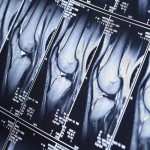
So you are in the middle of the football field, or have just been brought down off the ski mountain by a helicopter, and the certified athletic trainer or a physician on site has determined that you may have an anterior cruciate ligament injury. After you have recovered from the shock of having a serious injury, what do you do?
The next step is to see an orthopedic surgeon. When you are seen initially, the doctor may order X-rays to look for any possible fractures or depending on your age, to determine if you have open or closed growth plates (Growth plates are areas of developing cartilage tissue near the ends of long bones). X-rays will not show non-bony structures such as the anterior cruciate ligament. A MRI (magnetic resonance imaging) scan may also be ordered to evaluate the ACL and to determine if there is other damage to structures in the knee such as the meniscus, articular cartilage or other knee ligaments.
A physical exam will also be performed including special testing of the knee to determine the integrity of the ACL as well as evaluate for other injuries. For more a short video to show a lachman’s test, one that will evaluate the ACL, click here.
One thing to note is if it is determined that you may have an Anterior Cruciate Ligament tear and Surgery is suggested, it might not be recommended immediately.
Dr. Thomas Samuelson, one of the Sports Medicine Orthopaedic Surgeon’s at Kansas City Bone & Joint notes “It’s important to rehabilitate the knee after an injury to regain full motion and to improve the muscle tone. The swelling than often comes with an injury also needs to resolve. If the ACL reconstruction is performed before these things happen, the post-operative rehab is very difficult and the knee may become stiff.”
Our next article this month will discuss surgical treatment options.
written by: Amy Roberts MS, ATC/L
Kansas City Bone & Joint Clinic
Source and for further information: American Academy of Orthopaedic Surgeons (AAOS)

